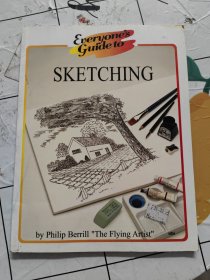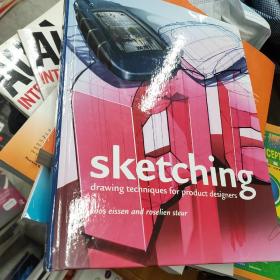
Sketching User Experiences Workbook
¥ 196 7.3折 ¥ 270 九五品
库存2件
作者Saul Greenberg
出版社Morgan Kaufmann Pub
ISBN9780123819598
出版时间2011-12
印刷时间2011-12
印数1千册
装帧平装
开本32开
纸张轻型纸
页数272页
字数1千字
定价270元
上书时间2024-10-23
- 在售商品 暂无
- 平均发货时间 30小时
- 好评率 暂无
- 最新上架
商品详情
- 品相描述:九五品
- 商品描述
-
基本信息
Format:Paperback / softback 272 pages
Publisher:Elsevier Science & Technology
Imprint:Morgan Kaufmann Publishers In
ISBN:9780123819598
Published:13 Dec 2011
Classifications:Product design, Research & development management, Technical design
Readership:Professional & Vocational
Weight:768g
Dimensions:275 x 217 x 15 (mm)
页面参数仅供参考,具体以实物为准
书籍简介
Sketching Working Experience: The Workbook provides information about the step-by-step process of the different sketching techniques. It offers methods called design thinking, as a way to think as a user, and sketching, a way to think as a designer. User-experience designers are designers who sketch based on their actions, interactions, and experiences. The book discusses the differences between the normal ways to sketch and sketching used by user-experience designers. It also describes some motivation on why a person should sketch and introduces the sketchbook. The book reviews the different sketching methods and the modules that contain a particular sketching method. It also explains how the sketching methods are used.
Readers who are interested in learning, understanding, practicing, and teaching experience design, information design, interface design, and information architecture will find this book relevant.
Key Features
Features standalone modules detailing methods and exercises for practitioners who want to learn and develop their sketching skills
Extremely practical, with illustrated examples detailing all steps on how to do a method
Excellent for individual learning, for classrooms, and for a team that wants to develop a culture of design practice
Perfect complement to Buxton’s Sketching User Experience or any UX text
Author-maintained companion website at
http://grouplab.cpsc.ucalgary.ca/sketchbook/
目录
Preface: How We Got Together to Write this Book
Acknowledgments
Section 1: Getting into the Mood
Chapter 1: Introduction
Chapter 2: Introduction: Sketching the User Experience
What This Book is About
Companion Book
Why Sketch?
Structure of This Book
Chapter 3: Why Should I Sketch?: A Synopsis of Buxton’s Sketching User Experiences: Getting the Design Right and the Right Design
Sketching is About Design
Getting the Design Right
Getting the Right Design
Elaboration and Reduction
The Design Funnel
The Product View
You Now Know
Chapter 4: The Sketchbook: Your Basic Resource for Recording, Developing, Showing and Archiving Ideas
Why a Sketchbook?
Uses of a Sketchbook
Best Practices
Properties of Good Sketchbooks
Drawing Materials
You Now Know
Chapter 5: 10 Plus 10: Descending the Design Funnel: Developing 10 Different Ideas and Refinements of Selected Ideas
The 10 Plus 10 Method
Design Challenge 1: Connecting Two Smart Phones
Design Challenge 2
Design Challenge 3
You Now Know
Section 2: Sampling the Real World
Chapter 6: Introduction
Chapter 7: Scribble Sketching: Rapidly Sketching Out Ideas – Anywhere, Anytime – to Capture the Essence of that Idea
Capturing Ideas in Existing Systems
Scribble Sketching in the Dark, While Doing Other Things
Practicing Scribble Sketching
You Now Know
Chapter 8: Sampling with Cameras: Capturing Trigger Moments
Sampling Objects That Irritate You and Others
Sampling Compelling Designs
Sampling Things That Inspire You
You Now Know
Chapter 9: Collecting Images & Clippings: Becoming a Semi-Organized Hunter/Gatherer
Developing Your Collection
Examples of Collections
You Now Know
Chapter 10: Toyboxes and Physical Collections: Collecting Physical Stuff
Part One: Collecting Objects as Idea Triggers
Collecting Objects to Build With
Part Two: Storing Objects
Part Three: Curating Your Objects
Case Study: The Buxton Collection
You Now Know
Chapter 11: Sharing Found Objects: Seeing Each Other’s Collections to Encourage Conversation
Sometimes things are private
Managing Sharing/Privacy Issues Around Sketching and Collecting
You Now Know
Section 3: The Single Image
Chapter 12: Introduction
Chapter 13: Warm Up to Sketching: A Sketching Exercise You Can Always Learn From
An Exercise in Line Quality
You Now Know
Chapter 14: Sketching What You See: An Exercise on Drawing Accurately
An Excercise in Drawing What You See
Part 1: Drawing From Your Imagination
Part 2: Copy a Drawing of a Person
Part 3: Drawing What You Actually See
Comparing the Results
You Try
You Now Know
Chapter 15: Sketching Vocabulary: Drawing Objects, People, and Their Activities
People Who Sketch on Computers
Learning How to Sketch
Comic Storytelling
You Now Know
Chapter 16: The Vanilla Sketch: Basic Elements Of A Sketch: Drawing, Annotations, Arrows and Notes
The Drawing
You Now Know
Chapter 17: The Collaborative Sketch: Sketching to Brainstorm, Express Ideas and Mediate Interaction
The Interactive Fridge
Actions and Functions of Collaborative Sketching
Gestures: Sketching with Others
You Now Know
Chapter 18: Slideware for Drawing: Exploiting Commonly Available Digital Presentation Tools for Sketch Drawing
Sketching in Slideware
Digital vs Paper-Based Sketching
Digital Collaboration
You Now Know
Chapter 19: Sketching with Office Supplies: Using Commonly Available Office Supplies to Create Editable Sketches
The Versatile Sticky Note
Interacting with Office Supplies Over Time
Using Office Supplies with Others
You Now Know
Chapter 20: Templates: Pre-Draw the Constant, Non-Changeable Parts of Your Sketch as a Template that You Can Use and Reuse
Appropriating Photos
More on Layers
Back to Paper
Another Example: a Web Page Template
You Now Know
Chapter 21: Photo Traces: Create Collections of Sketch Outlines that Form the Basis of Composed Sketches
Creating a Photo Trace
Using the Photo Traces
You Now Know
Chapter 22: Hybrid Sketches: Combining Sketches With Photos
You Now Know
Chapter 23: Sketching with Foam Core: Sketching in a Physical Medium
Method 1: Sketching a Novel Interface for a Digital Watch
Method 2: Using Photos to Prototype Existing Devices
You Now Know
Section 4: Snapshots in Time: The Visual Narrative
Chapter 24: Introduction
Chapter 25: Sequential Storyboards: Visually Illustrating an Interaction Sequence Over Time
The Sequential Storyboard
You Now Know
Chapter 26: The State Transition Diagram: A Way to Visually Illustrate Interaction States, Transitions and Decision Paths Over Time
A Storyboard as States and Transitions
Transition Diagram with Branches
You Now Know
Chapter 27: The Branching Storyboard: Visually Illustrating Interaction Decisions Over Time
The Cell Phone Example
The Interactive Shopping System Example
You Now Know
Chapter 28: The Narrative Storyboard: Telling a Story About Use and Context Over Time
A Vocabulary of Camera Shots and Film Making
Method 1: Sketching Storyboards
Method 2: Photo-Based Storyboards
You Now Know
Section 5: Animating the User Experience
Chapter 29: Introduction
Chapter 30: The Animated Sequence: Animating a Single Interaction Sequence of Registered Images
The Slide Show
The Registration Problem
The Solution: Registering Images
You Now Know
Chapter 31: Motion Paths: Smoothly Animating Movement Emphasizes the Feeling of Interaction
Explore Your Animation Tools
Other Animation Tools
You Now Know
Chapter 32: Branching Animations: Animating Different Interaction Paths in a Branching Sequence
Selecting Alternative Interaction Paths Through Hyperlinks
You Now Know
Chapter 33: Keyframes and Tweening: Creating More Complex Animations
Some Definitions
Example: Adobe Flash
You Try
You Now Know
Chapter 34: Linear Video: Using a Movie to Illustrate an Interaction Sequence With Paper
Recording The Movie
Variations: Paper and Transparency
You Now Know
Section 6: Involving Others
Chapter 35: Introduction
Chapter 36: Uncovering the Initial Mental Model: Discovering How People Initially Interpret Your Sketched Interface From its Visuals
Case Study: Usability of a Fax Machine
Uncovering the Mental Model
You Now Know
Chapter 37: Wizard of Oz: A Human ‘Wizard’ Controls How Your Sketch Responds to a Person’s Interactions
Example 1: The Listening Typewriter
Example 2: Robotic Interruption
Example 3: The Fax Machine
You Now Know
Chapter 38: Think Aloud: Discovering What People are Thinking as they Use Your Sketched Interface
Steps of Think Aloud
You Now Know
Chapter 39: Sketch Boards: Arrange Your Sketches On Poster Boards to Share them With Others
Preparation Method 1: Foam Core Poster Sheets
Preparation Method 2: Sticky Notes and Whiteboards
Share Your Sketches with Others
You Now Know
Chapter 40: The Review: Presenting Your Ideas and Getting Others to Critique Them
The Elevator Pitch
The Desktop Review
The Meeting
The Formal Review (or the Crit)
You Now Know
Index
相关推荐
-

SKetching USER EXPERIENCES勾勒用户体验
八品宁波
¥ 264.00
-

Sketching User Experiences:The Workbook (大16开)
九品北京
¥ 160.00
-

Sketching User Experiences英文原版用户体验草图设计
九五品广州
¥ 388.00
-

Sketching User Experiences: Getting the Design Right and the Right Design
九品
¥ 130.00
-

Sketching
八五品北京
¥ 100.00
-

SKETCHING
九品沧州
¥ 50.00
-

SKETCHING
八五品长沙
¥ 50.00
-

sketching
九五品苏州
¥ 70.00
-

Designing the iPhone User Experience:A User-Centered Approach to Sketching and Prototyping iPhone Apps
九品平顶山
¥ 258.00
-

SKETCHING INTERIORS
九品广州
¥ 16.00
— 没有更多了 —



















以下为对购买帮助不大的评价